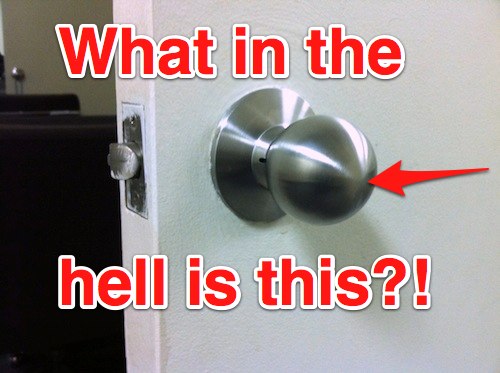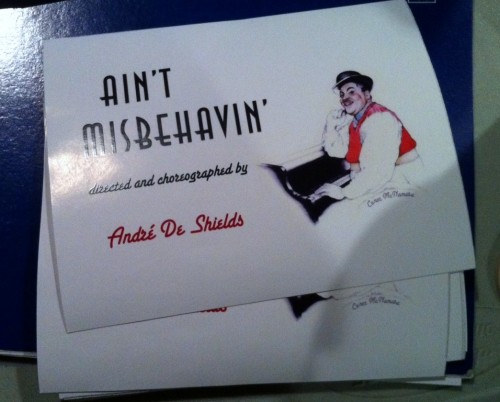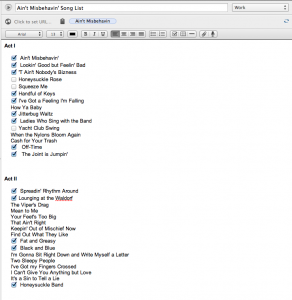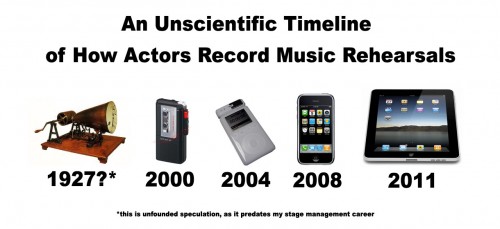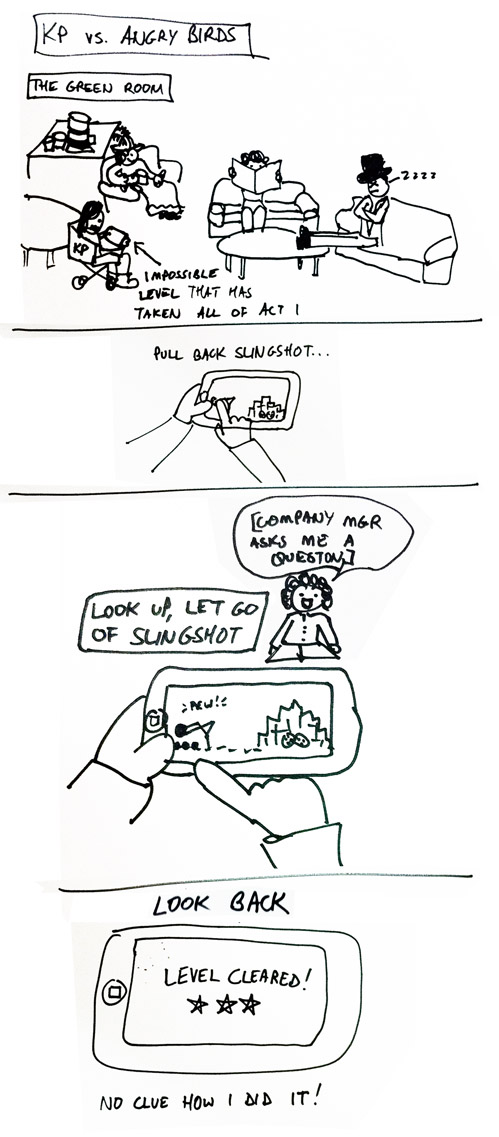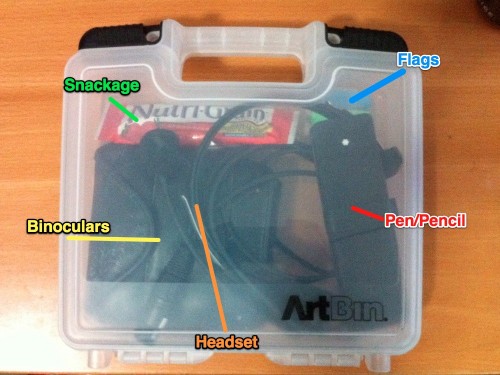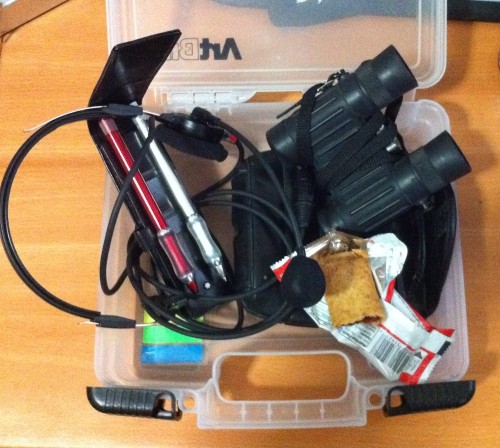Now that Apple has released iOS 5, here are a few new features I’m finding particularly useful for stage management.
Reminders
If you’re a seriously anal stage manager with some disposable income, you may have already invested in some of the more robust and expensive task management apps like OmniFocus or Things, but if you like to keep your tasks more simple or cost-free, the Reminders app is a great addition. It also syncs with iCloud so you can see your tasks on all your iOS or Mac devices. One of the features of this app, and the new OS in general, that I’m most excited about is geofencing — the ability to have it remind you when you enter or leave a certain place (like your home or theatre) based on your GPS location.
I’m a heavy OmniFocus user, but I think I’ll probably be using Reminders to keep track of simpler short-term tasks like shopping lists. I also want to compare the geofencing abilities of Reminders versus OmniFocus.
Clock
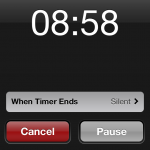 Please note, the timer now has a “pause” function. I’m struggling a little with when you would use this — perhaps if the earth stops rotating for a few minutes while you’re on a ten? But I add it because it’s the kind of feature Phil Schiller is never going to bother to tell you about in a product launch, and you may have more inventive uses for the timer in your workflow than I do.
Please note, the timer now has a “pause” function. I’m struggling a little with when you would use this — perhaps if the earth stops rotating for a few minutes while you’re on a ten? But I add it because it’s the kind of feature Phil Schiller is never going to bother to tell you about in a product launch, and you may have more inventive uses for the timer in your workflow than I do.
iCal
Week view in iCal!!!!!!
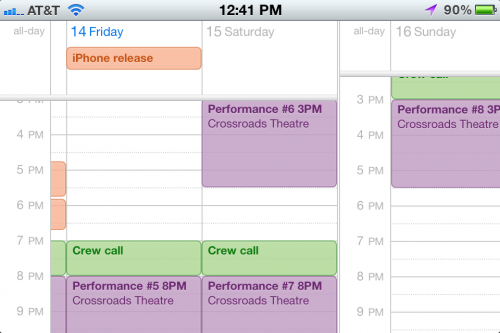
I don’t know about you, but I always have my calendar in week view on the Mac. With the Retina Display, I couldn’t fathom why I couldn’t have a teeny-tiny week view on my phone, too. Well now if you tip the phone sideways, you can. Only one minor nitpick from a stage management perspective: when you swipe to the side to advance through the days, it has a little division between Saturday and Sunday, denoting the new week. Of course the Equity week starts on Monday, and there’s no way to change this. So if you’re counting hours on your tiny screen, you may be a little distracted by having to break up the week differently than is indicated, but this is a very minor inconvenience compared to the awesomeness of having a week view at all.
Note: there is one roundabout way to do this: under Settings/General/Date-Time/International you can select United Kingdom, and that will fix your week start problem and leave you with a host of other problems in the formatting of your date, time, phone numbers, etc. Unless you’re British, at which point you’re totally set already and are probably wondering why we silly Yanks start the week on Sunday anyway.
Flags in Mail!!!
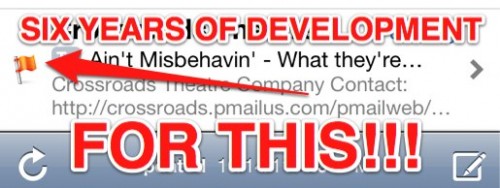
Finally! Seriously!! How hard was this? This is one of those things that even the simplest mail client on any device should be able to do. I could do a Let Me Tell Ye on this alone, but now it’s fixed and all is forgiven, so I won’t. You may now go about marking emails you need to follow up on, and when you look at them on your phone they won’t blend in with whatever other crap is in your inbox.
I should also mention that I’m having some issues with flag status updating between devices. So it’s more of a theoretical “finally” than an actual solution. It seems to work better on my iCloud account than on Gmail.
Notification Center
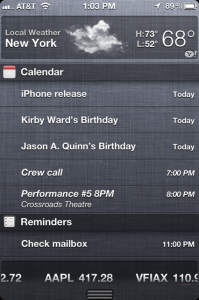 Finally iPhone users who don’t jailbreak can have a feature that other smartphone users had over 5 years ago — something we used to call a “today screen” back in the PDA days, which was even longer ago.
Finally iPhone users who don’t jailbreak can have a feature that other smartphone users had over 5 years ago — something we used to call a “today screen” back in the PDA days, which was even longer ago.
One of my favorite things about this little applet is that I was on a train last night and every time I looked at my notifications, the weather had updated with whatever city the train was passing through. I didn’t even notice it, it was just there. This would be great for the road — no more having to remember to update your weather app with where you are.
You can pretty heavily customize (for Apple, at least) the apps that appear on this screen, and how much they show you, and in what order. One problem is that you don’t have control over what calendars you can see. So say I have a work calendar (don’t be silly, I have six work calendars) and a personal calendar, but I don’t want to clutter up my notifications with my personal appointments — you can’t turn that off, even if you hide that calendar in iCal. What’s worse is that you can’t get rid of the birthdays calendar. So one day when I had three contacts with birthdays, that took up most of my 5 appointment slots, and pushed off things like, you know, the performance I had that night. You can have it show you 10 appointments, but then you’d have to scroll to see any other type of notifications. It would be great to be able to hide certain calendars from the notifications screen, and give them an order of importance, the way you can with what apps appear.
It would also be nice to get rid of that nasty linen background, but I assume we will have to jailbreak or wait for several years to pass before that happens. The linen, it grows on me not.
Find Friends
This would be awesome on the road. You’re on lunch break during load-in, and somebody finds a cool restaurant. See where all the members of your cast/crew are during the day and meet up somewhere. Nick and I once walked all the way around the campus of Minnesota State University Moorehead in like a foot of snow, on top of a sheet of ice, looking for our bus, and never found it. Now we could just walk directly to the location of our colleagues on the bus.
Otherwise it’s a little stalkerish, but this app would be amazing for keeping track of a group in an unfamiliar place, which is pretty much the definition of stage management on the road.
iCloud
I don’t think of this as a big deal because I’ve had MobileMe and Google Apps for years, but if you haven’t been syncing your contacts, calendar, emails and bookmarks instantly over the cloud, you now have no excuse not to enjoy the convenience and security of knowing that your data is updated everywhere without you having to do anything.


